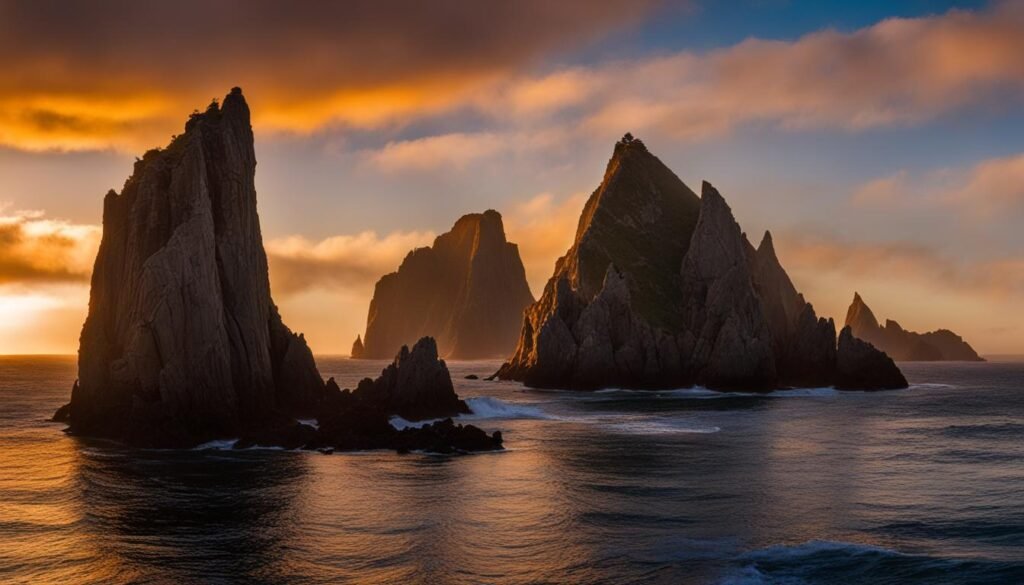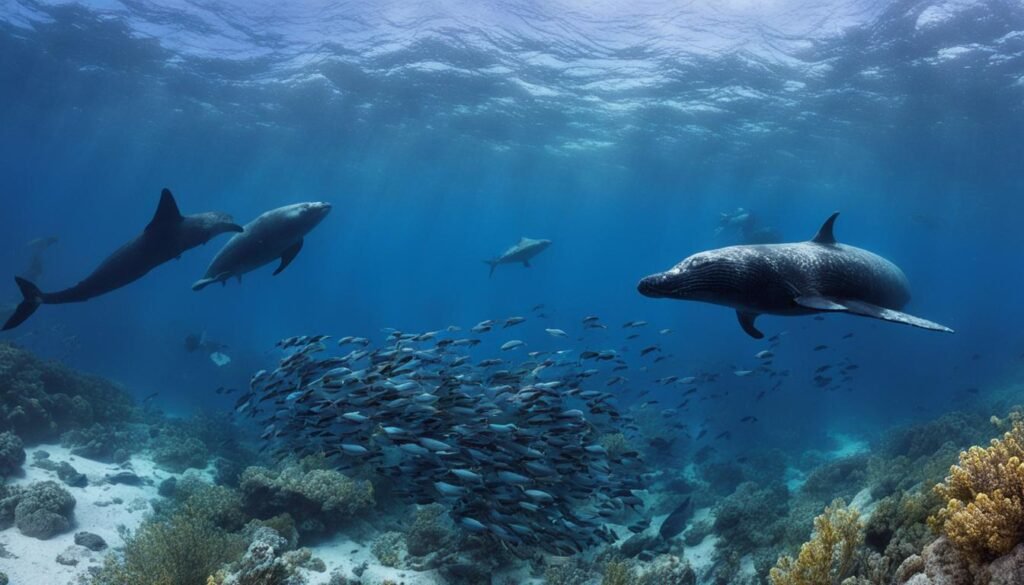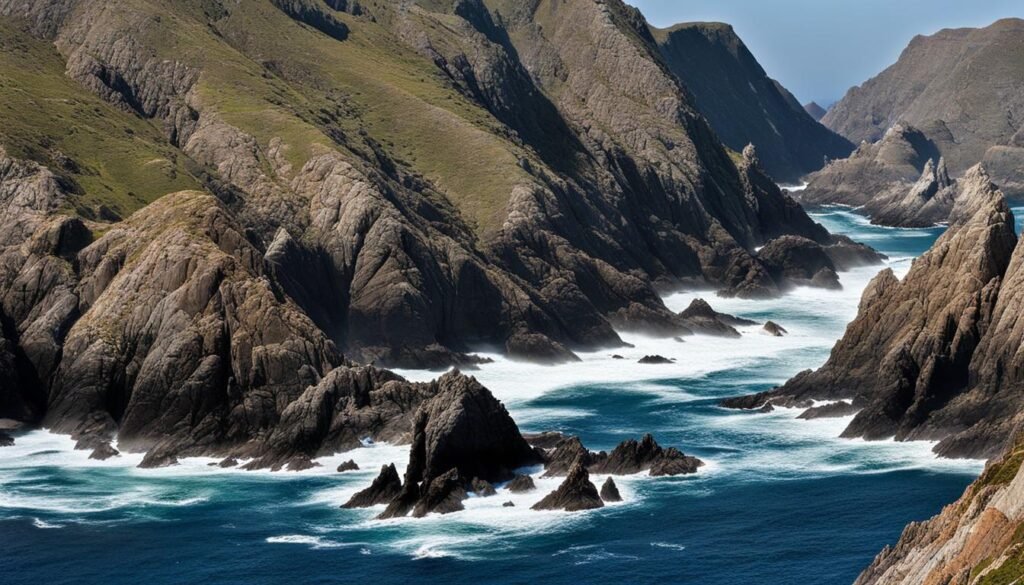The Farallon Islands, also known as the Farallones, are a group of islands located off the coast of San Francisco. These islands are a haven for seabirds, marine life, and adventure. They offer breathtaking views of the Pacific Ocean and provide a unique opportunity to witness the diverse wildlife that inhabits this marine ecosystem. Visitors can explore the islands through ecotourism activities such as birdwatching, diving, and whale watching. The Farallon Islands are also a designated wildlife sanctuary and a crucial breeding ground for many species, including great white sharks. Conservation efforts are in place to protect this natural treasure.
Key Takeaways:
- The Farallon Islands are a group of islands located off the coast of San Francisco.
- They offer breathtaking views of the Pacific Ocean and are a haven for seabirds and marine life.
- Visitors can engage in ecotourism activities such as birdwatching, diving, and whale watching.
- The islands are a designated wildlife sanctuary and crucial breeding ground for many species.
- Conservation efforts are in place to protect the unique ecosystem of the Farallon Islands.
Exploring the Farallon Islands
To visit the Farallon Islands, you can book tours that depart from San Francisco. These tours offer a unique opportunity to explore the islands and observe the diverse wildlife.
The South Farallon Islands are the main destination for visitors, as they are home to a variety of seabirds, marine mammals, and sharks. The islands can be reached by boat from San Francisco, and the journey takes approximately 30 miles and lasts about 3 hours.
Once on the islands, visitors can witness the incredible diversity of animal species, including seabirds like gulls, cormorants, and puffins, as well as marine mammals like seals and sea lions.
The Marine Ecosystem of the Farallon Islands
The Farallon Islands are located within the Greater Farallones National Marine Sanctuary, which is a protected marine ecosystem. The sanctuary covers an area of about 3,000 square miles and is dedicated to the conservation and preservation of the region’s marine life and habitats.
The islands themselves are characterized by their jagged cliffs and rocky shores, providing ideal breeding grounds for seabirds and marine mammals. These rugged cliffs serve as natural habitats for a variety of nesting seabirds, including gulls, cormorants, and puffins. The rocky shores provide a safe haven for marine mammals such as seals and sea lions to rest and give birth to their young.
The Importance of Conservation Efforts
Conservation efforts are crucial in protecting the delicate marine ecosystem of the Farallon Islands. The sanctuary is managed by multiple organizations, including the U.S. Fish and Wildlife Service and the National Oceanic and Atmospheric Administration, who work together to ensure the long-term survival of the diverse marine species that inhabit the area.
These conservation efforts include monitoring the populations of different species, implementing fishing regulations to prevent overfishing, and establishing protected marine zones. By conserving the marine ecosystem of the Farallon Islands, we not only protect the plants and animals that call it home but also contribute to the overall health of the ocean.
Preserving a Marine Sanctuary for Future Generations
The Farallon Islands’ designation as a marine sanctuary ensures its protection for future generations to enjoy. Preserving this unique ecosystem allows researchers and scientists to continue studying and understanding the intricate connections between marine species and their habitats.
Not only does the sanctuary provide valuable research opportunities, but it also offers a chance for visitors to appreciate the beauty and wonder of the marine world. Whether it’s diving among vibrant coral reefs, observing playful seals and sea lions, or witnessing the grace of soaring seabirds, the Farallon Islands showcase the magnificence of marine life.
By raising awareness about the importance of marine conservation, we can inspire others to join in the efforts to protect our oceans and ensure a sustainable future for these extraordinary ecosystems.

Wildlife of the Farallon Islands
The Farallon Islands are a haven for wildlife enthusiasts, offering a diverse array of species that call these rugged islands home. From seabirds to sharks, there’s no shortage of fascinating creatures to observe and admire.
Seabirds
The Farallon Islands are a vital breeding ground for seabirds, hosting over 300,000 individuals from 13 different species. Among the most iconic are the tufted puffin, known for its vibrant beak and adorable appearance. The common murre, with its distinctive black and white plumage, is another seabird species commonly found on the islands. Additionally, the majestic western gull can be spotted soaring above the rocky shores.
Sharks
The Farallon Islands are renowned for their population of great white sharks, attracting these ocean predators due to the abundant seal and sea lion populations. Observing these magnificent creatures in their natural habitat is a thrilling experience for visitors. While the great white sharks may be elusive and mysterious, they are an essential part of the marine ecosystem in these waters.
Birdwatching Opportunities
Birdwatching enthusiasts will be captivated by the opportunities presented on the Farallon Islands. The islands provide a unique vantage point to observe seabirds nesting, feeding, and taking flight. Whether it’s photographing the tufted puffin in its natural habitat or observing the graceful flight patterns of the western gull, birdwatching on the Farallon Islands is an experience to remember.
Visitors to the Farallon Islands are treated to an abundance of wildlife, from the seabirds nesting along the rocky cliffs to the great white sharks patrolling the surrounding waters. Exploring the rich biodiversity of these islands is an adventure that leaves a lasting impression.
History and Conservation Efforts
The Farallon Islands have a fascinating history that spans thousands of years. These captivating islands were first inhabited by Native Americans, who recognized their beauty and abundance. Later, they served as crucial landmarks for European explorers navigating the treacherous Pacific Ocean.
In the 19th century, the Farallon Islands became a hub for fur traders, drawn by the rich marine life that thrived in the surrounding waters. The islands also played a significant role during World War II, serving as a military outpost to protect the San Francisco Bay.
Today, the Farallon Islands are part of the Greater Farallones National Marine Sanctuary and are managed by esteemed organizations like the U.S. Fish and Wildlife Service and the National Oceanic and Atmospheric Administration. These agencies work tirelessly to protect and conserve the islands’ unique ecosystem.
Conservation efforts are focused on preserving the delicate balance of the islands’ marine life and ensuring the survival of the diverse array of wildlife that calls this place home. The Farallon Islands are renowned for their vital role as a breeding ground for seabirds and as a sanctuary for numerous marine mammals, including seals, sea lions, and the awe-inspiring great white sharks.
Preserving the Farallon Islands is not only important for our current generation but also for future generations to cherish and enjoy. By safeguarding these islands and their remarkable natural heritage, we are maintaining a legacy that speaks to our commitment to the beauty and wonder of our planet’s marine ecosystems.

Conservation Efforts at the Farallon Islands:
- Protection of the islands as part of the Greater Farallones National Marine Sanctuary
- Management by esteemed organizations like the U.S. Fish and Wildlife Service and the National Oceanic and Atmospheric Administration
- Preservation of the islands’ unique ecosystem
- Ensuring the survival of diverse wildlife, including seabirds, marine mammals, and sharks
Next, let’s explore the thrilling activities and opportunities for eco-adventures at the Farallon Islands.
Ecotourism and Activities
The Farallon Islands offer a range of exciting ecotourism activities for visitors to enjoy. Whether you’re an avid diver, a wildlife enthusiast, or simply seeking a unique adventure, these islands have something for everyone.
Diving
If you’re a diving enthusiast, you’ll be thrilled by the underwater world surrounding the Farallon Islands. The crystal-clear waters teem with marine life, creating a truly immersive experience. Explore vibrant kelp forests, encounter curious sea lions, and marvel at the colorful array of fish that call these waters home. With great visibility and diverse marine ecosystems, diving here is an unforgettable experience.
Whale Watching
One of the most incredible sights at the Farallon Islands is the annual migration of gray whales. Join a whale watching tour and witness these majestic creatures as they pass through these waters on their journey. Keep your eyes peeled for other whale species, such as humpback and minke whales, which are occasionally spotted during the migration season. It’s a once-in-a-lifetime opportunity to see these magnificent animals in their natural habitat.
Guided Tours
If you want to learn more about the history, wildlife, and conservation efforts of the Farallon Islands, guided tours are available. Expert guides will accompany you as you explore the islands, providing fascinating insights into the unique ecosystem and the conservation challenges it faces. Immerse yourself in the natural beauty of the islands, snap breathtaking photos, and gain a deeper appreciation for this remarkable place.
Whether you’re diving into the depths, spotting whales from the surface, or embarking on a guided tour, the Farallon Islands are sure to leave you with lasting memories. Experience the wonders of these pristine islands and witness the extraordinary marine life that thrives in this secluded sanctuary.
- Explore the underwater world teeming with marine life.
- Witness the annual migration of gray whales.
- Spot other whale species, such as humpback and minke whales.
- Join guided tours to learn about the islands’ history and wildlife.
- Immerse yourself in the natural beauty of the Farallon Islands.
Conclusion
The Farallon Islands are a true natural wonder, offering visitors a unique glimpse into the world of marine mammals, seabirds, and sharks. The islands’ jagged cliffs, pristine waters, and rich biodiversity make for an unforgettable experience. As a designated wildlife sanctuary and marine reserve, the Farallon Islands are protected for future generations to enjoy.
Exploring the Farallon Islands provides an opportunity to witness the incredible diversity of marine life, including magnificent marine mammals like seals, sea lions, and the majestic gray whales. The islands are a haven for seabirds, with numerous species nesting and thriving in this pristine environment.
Whether you’re an avid birdwatcher, an adventure seeker looking to dive into the vibrant underwater world, or someone who simply appreciates the beauty of nature, a visit to the Farallon Islands is sure to leave you in awe. So come and immerse yourself in the breathtaking scenery and experience the wonders of this marine reserve firsthand.
FAQ
Can I visit the Farallon Islands?
Yes, you can visit the Farallon Islands by booking tours that depart from San Francisco.
How do I get to the Farallon Islands from San Francisco?
The Farallon Islands can be reached by boat from San Francisco. The journey takes approximately 30 miles and lasts about 3 hours.
What can I see on the Farallon Islands?
The Farallon Islands are home to a diverse range of wildlife, including seabirds like gulls, cormorants, and puffins, as well as marine mammals like seals and sea lions.
Are the Farallon Islands a wildlife sanctuary?
Yes, the Farallon Islands are a designated wildlife sanctuary and are protected for conservation purposes.
What ecotourism activities can I do on the Farallon Islands?
Visitors to the Farallon Islands can enjoy activities such as birdwatching, diving, and whale watching.
How can I learn more about the history and conservation efforts of the Farallon Islands?
Guided tours are available to explore the islands and learn about their history, wildlife, and conservation efforts.







